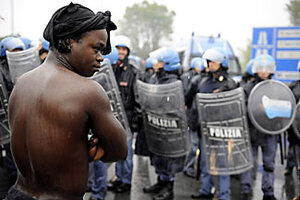'Xenophobic climate' fueling policies, violence in Italy
The recent death of an African immigrant in Milan highlights racial and ethnic tensions.

ANGER: Italian immigrants protested, sometimes violently, July 19 near Naples over the deaths of six African immigrants.
Salvatore Laporta/AP
Milan, Italy
For the past two weeks, groups of teenagers have mourned in front of "Shining," a snack bar not far from Milan's Central Station. Many leave flowers and cards. But some leave cookies and two euros, a provocative gesture referencing the killing of Abdul Guibre: the 19-year-old African-Italian youth who was allegedly beaten to death Sept. 14 by two shop owners for having stolen some cookies, worth a few euros.
This death comes on the heels of a recent wave of racially motivated attacks in Italy that are raising concerns about violence against minorities, and a potential backlash from those who feel they are unfairly treated as second-class citizens.
"This is the poisoned fruit of a process that began in the early 1990s, when the first boats of migrants came from Albania," says Jean Leonard Touadi, a lawmaker in Parliament and an African-Italian born in Congo. "Since then, a syndrome of invasion, fueled by extremists, has been spreading in the broader public, even though until recently Italy [had] a lower migration rate than the rest of Europe."
Tensions between Italians and immigrants have run high this year. On Aug. 18, the son of an Angolan diplomat was beaten in Rome by a neo-Nazi group. Earlier in the summer, Roma (gypsy) camps were set on fire near Naples. Six African immigrants were killed in September in a small town in central Italy, though some reports say it was a Mafia killing.
"Unfortunately the life of someone who is perceived as different is not worth much these days" says Mr. Touadi, who adds he is deeply troubled by what he calls "a climate of growing xenophobia."
Touadi accuses parts of the right-wing government, which includes the anti-immigration party Northern League, of appealing to Italians' economic and social concerns by scapegoating foreigners. Some 12,000 illegal immigrants have been apprehended here in 2008. Recently, the government passed a series of anticrime measures that seem designed to target migrants and minorities.
In July, Italian authorities began a gypsy census, creating files on the Roma living in some 700 camps across the country. The measure was seen as discriminatory by some human rights organizations, as many Roma hold Italian citizenship. But 60 percent of Italians supported the census, according to one poll.
This summer, the military began monitoring Italy's 16 detention centers for migrants waiting either for asylum or expulsion, in response to a declared "state of emergency" on immigration. The government also introduced a law allowing illegal immigrants convicted of crimes to be held up to one-third longer than Italians convicted of the same offense.
The shop owners have admitted beat ing Guibre, who was born in Burkina Faso, but deny any racial motivations, saying that they chased him intending only to get their money back. The men were charged with voluntary manslaughter, but were not charged with participating in a racially motivated attack, which would have come with a harsher sentence.
Milan's African community, which includes both immigrants and Italian citizens, met the prosecutor's decision with anger. Some 7,000 attended a protest on Sept. 20 in the city center. While the protest was mostly peaceful, several black youths damaged motorcycles and garbage bins. Riots were reported in Cernusco, a Milan suburb with a significant black population, where Guibre used to live.
"The risk of racial riots is high. Nowadays Milan reminds me of Paris during the [2005] Banlieue revolt, or London at the time of the [1981] Brixton riots," says writer Nicoletta Vallorani, referring to the hostilities between authorities and alienated minority youth that other European cities began experiencing decades ago.
Italy is relatively new to racial clashes. But that's changing, especially in the industrialized north, where a solid economy since the early 1990s has drawn foreign workers, mostly from North Africa and Eastern Europe. Today immigrants and their families make up about 5 percent of the country's population. In Milan, immigrants make up more than 12 percent.
